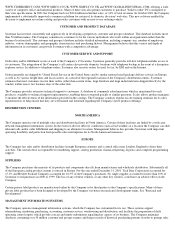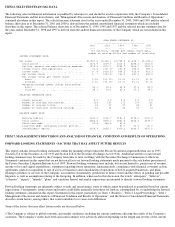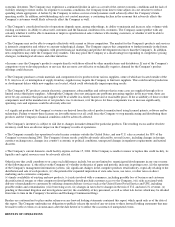Circuit City 2001 Annual Report Download - page 16
Download and view the complete annual report
Please find page 16 of the 2001 Circuit City annual report below. You can navigate through the pages in the report by either clicking on the pages listed below, or by using the keyword search tool below to find specific information within the annual report.the liability is adjusted to its present value each period, and the capitalized cost is depreciated over the useful life of the related asset. Upon
settlement of the liability, an entity either settles the obligation for its recorded amount or incurs a gain or loss upon settlement. The standard is
effective for fiscal years beginning after June 15, 2002. The adoption of SFAS 143 is not expected to have a material impact on the Company's
financial position or results of operations.
In October 2001, the FASB issued SFAS 144 "Accounting for the Impairment or Disposal of Long-
Lived Assets". SFAS 144 supercedes SFAS
121, "Accounting for the Impairment of Long-Lived Assets and for Long-Lived Assets to Be Disposed Of", however, it retains many of its
fundamental provisions. SFAS 144 requires that long-lived assets be measured at the lower of carrying amount or fair value less cost to sell,
whether reported in continuing operations or in discontinued operations. Therefore, discontinued operations will no longer be measured at net
realizable value or include amounts for operating losses that have not yet occurred. SFAS 144 also broadens the reporting of discontinued
operations to include all components of an entity with operations that can be distinguished from the rest of the entity and that will be eliminated
from the ongoing operations of the entity in a disposal transaction. The provisions of this Statement are effective for financial statements issued
for fiscal years beginning after December 15, 2001. The adoption of SFAS 144 is not expected to have a material impact on the Company's
financial position or results of operations.
IMPLICATIONS TO THE COMPANY FROM THE ADOPTION OF A EUROPEAN COMMON CURRENCY
The countries of the European Union have adopted a single currency, the "Euro." The Euro came into existence on January 1, 2000, and could
have been used for transactions within and between the countries of the Economic and Monetary Union (Austria, Belgium, Finland, France,
Germany, Netherlands, Ireland, Italy, Luxembourg, Portugal and Spain), with national currencies expressed as a denomination (national
currency units) of the Euro. During the three-year transition period following its introduction, countries were allowed to transact business both
in the euro and in their own currencies at fixed exchange rates. On January 1, 2002, the Euro became the only currency in Economic and
Monetary Union countries.
The Company has extensive operations in Europe, including France, Germany, Italy, the Netherlands, Spain, Sweden, England and Scotland. It
also sells into additional countries in Europe. For the 2001 fiscal year, approximately 36.5% of the Company's net sales were in Europe. With
the exception of Sweden and the United Kingdom, all of the countries in which the Company has operations are participants in the European
common currency, the Euro. The introduction of the Euro has not required a significant modification to the Company's accounting systems and
has not had a significant adverse impact on European sales or pricing. There is no expectation of a significant adverse impact in the future. The
Company adopted the Euro for internal systems and reporting as of January 1, 2002.
ITEM 7A. QUANTITATIVE AND QUALITATIVE DISCLOSURE ABOUT MARKET RISK.
The Company is exposed to market risks, which include changes in U.S. and international interest rates as well as changes in currency
exchange rates as measured against the U.S. dollar and each other.
The Company has no involvement with derivative financial instruments and does not use them for trading purposes. Changes in currency
exchange rates as measured against the U.S. dollar may positively or negatively affect Systemax's sales, gross margins, operating expenses and
retained earnings as expressed in U.S. dollars. The Company may enter into foreign currency options or forward exchange contracts aimed at
limiting in part the impact of certain currency fluctuations, but as of December 31, 2001 the Company had no outstanding forward exchange
contracts.
ITEM 8. FINANCIAL STATEMENTS AND SUPPLEMENTARY DATA.
The information required by Item 8 of Part II is incorporated herein by reference to the Consolidated Financial Statements filed with this report;
see Item 14 of Part IV.
ITEM 9. CHANGES IN AND DISAGREEMENTS WITH ACCOUNTANTS ON ACCOUNTING AND FINANCIAL DISCLOSURE.
None.
PART III
ITEM 10. DIRECTORS AND EXECUTIVE OFFICERS OF THE REGISTRANT.
The information required by Item 10 of Part III is hereby incorporated by reference from the Company's Proxy Statement for the 2002 Annual
Meeting of Stockholders (the "Proxy Statement").
ITEM 11. EXECUTIVE COMPENSATION.
The information required by Item 11 of Part III is hereby incorporated by reference from the Proxy Statement.
ITEM 12. SECURITY OWNERSHIP OF CERTAIN BENEFICIAL OWNERS AND MANAGEMENT.
























